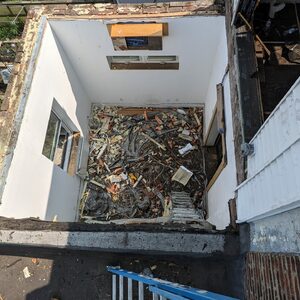*
Bear, I ran mine through as close as possible to the ridge as to have the roof flange go under the ridge cap and avoid any leak or maintenance problem. Also this makes a safe place for the chimney as sliding snow is not likely to rip it off or damage it. If you can install your stove with the SS pipe straight out (no elbows) is the best and most economical installation. Keith
Discussion Forum
Discussion Forum
Up Next
Video Shorts
Featured Story

New devices showcased at the Builders' Show make it easy to measure glass performance, u-factor, SHGC, window thickness, and more.
Featured Video
How to Install Cable Rail Around Wood-Post CornersHighlights
"I have learned so much thanks to the searchable articles on the FHB website. I can confidently say that I expect to be a life-long subscriber." - M.K.
Fine Homebuilding Magazine
- Home Group
- Antique Trader
- Arts & Crafts Homes
- Bank Note Reporter
- Cabin Life
- Cuisine at Home
- Fine Gardening
- Fine Woodworking
- Green Building Advisor
- Garden Gate
- Horticulture
- Keep Craft Alive
- Log Home Living
- Military Trader/Vehicles
- Numismatic News
- Numismaster
- Old Cars Weekly
- Old House Journal
- Period Homes
- Popular Woodworking
- Script
- ShopNotes
- Sports Collectors Digest
- Threads
- Timber Home Living
- Traditional Building
- Woodsmith
- World Coin News
- Writer's Digest


















Replies
*
Bear, I ran mine through as close as possible to the ridge as to have the roof flange go under the ridge cap and avoid any leak or maintenance problem. Also this makes a safe place for the chimney as sliding snow is not likely to rip it off or damage it. If you can install your stove with the SS pipe straight out (no elbows) is the best and most economical installation. Keith
*
There are products specifically designed for this called "deck boots." They come in various elastomers for any type of vent.
*Bear,Price of SS double wall being what it is you may want to consider an alternative. For pole barn shops folks around here put up a masonry chimney about one foot from a wall. The chimney is made from special purpose shapes available at any block yard and ceramic liners. Any competent mason can put one up on a poured concrete footing in less than a day. The stove is positioned by the wall and the flue runs up and then out through a thimble and into the chimney. A clean out at the bottom of the chimney makes it easy to remove sweeping residue. You may also want to brace the chimney to the barn with metal straps. If this sounds workable I suggest you contact a mason and get an estimate. Should be competitive with double wall SS.
*
Bear
I propose an alternative method which I have used sucessfully many times in residential applications. Build a square chimney chase to extend above the roof line 18"-24" and flash it to the roof with stock metal roofing "side wall' and "end wall" flashing. You can then locate your heater where ever you like, and keep the chimney run straight! The inside of the chase must have 2" of clearance all around the chimney (so called zero clearance) but can be made of 1x3 and 1/2" ply. You then purchase a 'cone flashing' for a flat roof and bend the edges over the sides of the chase. Careful overlapping of all flashings yields a very tight unit. Finish the exterior with the same roofing metal or whatever.
*From my woodstove experience i'd say the double wall stainless is the best way to go and will give least problems with creosote build-up. I'd make sure the pipe is well supported and not touching truss or roof framing members--but run near enough to attach with stand-offs to secure pipe. I would allow only a 1/4" of clearance where it goes though metal roof so roofing gives final support from shaking/movement of pipe. I used silicone II to seal cone and sheetmetal screwheads from leaks--under the edges and along edges after screwed down. It's important that pipe weight is not borne by the woodstove. Stay warm!
*
I am going to run an insulated s.s.
chimney (for a woodstove) through a
metal pole barn type roof 4/12 pitch
with a cone flashing. Does anyone have
any suggestions, hints, or techniques?
Thank you for your h